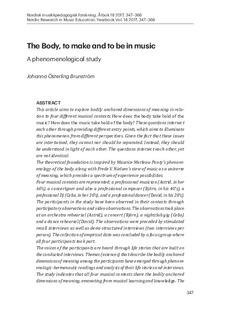| dc.description | This article is an account of the author's dissertation: The Body, to make and to be in music. A phenomenological study (Österling Brunström, 2015). The article illuminates the thesis’ central parts, including the four musical contexts, theoretical framework, method, results and discussion. | nb_NO |
| dc.description.abstract | ABSTRACT -
This article aims to explore bodily anchored dimensions of meaning in relation to four different musical contexts. How does the body take hold of the music? How does the music take hold of the body? These questions intersect each other through providing different entry points, which aims to illuminate this phenomenon from different perspectives. Given the fact that these issues are intertwined, they cannot nor should be separated. Instead, they should be understood in light of each other. The questions intersect each other, yet are not identical.
The theoretical foundation is inspired by Maurice Merleau-Ponty’s phenomenology of the body, along with Frede V. Nielsen’s view of music as a universe of meaning, which provides a spectrum of experience possibilities. Four musical contexts are represented; a professional musician (Astrid, in her 60’s), a concertgoer and also a professional composer (Björn, in his 40’s), a professional DJ (Celia, in her 30’s), and a professional dancer (David, in his 20’s). The participants in the study have been observed in their contexts through participatory observations and video observations. The observations took place at an orchestra rehearsal (Astrid), a concert (Björn), a nightclub gig (Celia) and a dance rehearsal (David). The observations were preceded by stimulated recall interviews as well as demi-structured interviews (two interviews per person). The collection of empirical data was concluded by a focus group where all four participants took part.
The voices of the participants are heard through life stories that are built on the conducted interviews. Themes (essences) that describe the bodily anchored dimensions of meaning among the participants have emerged through phenomenologic- hermeneutic readings and analysis of their life stories and interviews. The study indicates that all four musical contexts share the bodily anchored dimensions of meaning, emanating from musical learning and knowledge. The four contexts also share experiences of the aesthetic, emotional and existential relations to musicking. The room also plays a significant role, together with body and communication.
The musician and the DJ express the dual aspect of the body, e.g. to have and to be in a body, and also the distinction between a professional and a private body. The concertgoer/composer and the musician both highlight how the body can expose the person through stress, nervousness and habitus. The concertgoer/ composer also illustrates how language emanates from bodily gestures.
When the body takes hold of the music, it occurs through an intentional act, through a reaching out in the world – an act of doing. When the music takes hold of the body, it involves becoming shaken, touched and, without notice, being struck by music – an act of being. Between doing and being, there is a gap – the flesh – that can be understood as our existence.
Keywords: body and music, phenomenology, aesthetic, emotional and existential
experience | nb_NO |
